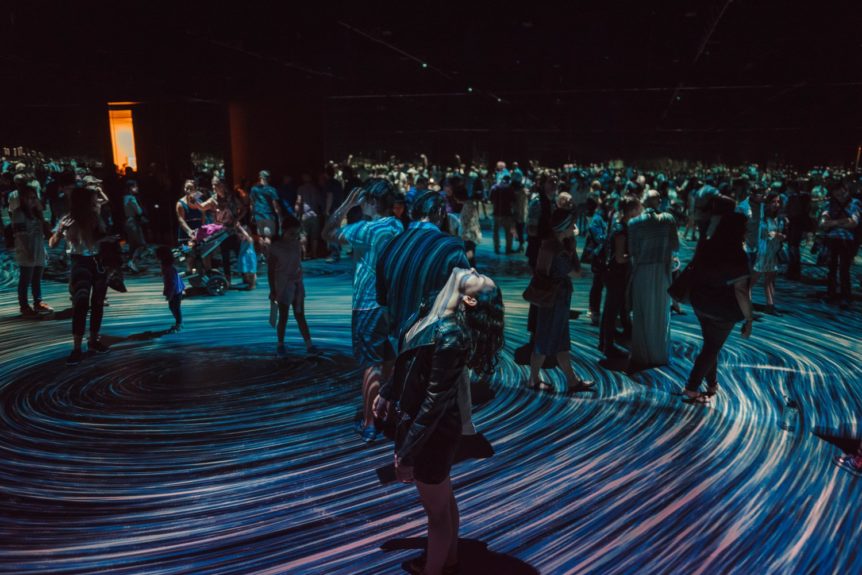As a technology provider, our job is to stay at the forefront of emerging technologies and tools while also considering the application of these tools for event production and various settings.
Projection mapping is an exciting new technology in event production. Recently, projection mapping has been used to display graphics or animation on the sides of European castles or in blockbuster movies. We’re excited about the variety of ways this technology of projection mapping can be used in our event productions.
What is Projection Mapping?
Let’s start with the basics. Projection mapping uses video, animation, graphics, and images—along with projectors—to project on any surface. From building facades to set pieces to sports fields, images are displayed in high-definition quality regardless of the surface.
Projection mapping is still a developing field, but already has the attention of several industry experts at the forefront. DWP Live www.dwplive.com is one of those experts. Since DWP Live was founded in 2007, Danny Whetstone, along with DWP Live’s expert team of programmers, projectionists and technicians have helped produce shows globally.
“It’s completely scalable, from a city block all the way down to the size of a smaller product, like an athletic shoe,” says DWP president, Danny Whetstone.
Projection Mapping Applications for Events
Mapping can be used in a multitude of ways on a small scale or large scale for a conference or event. If you can imagine it, projection mapping can create it. How you use it depends on the goals and desired outcomes of the event. When you are exploring incorporating any technology into your event, you should consider how it will achieve the goal: your attendees walking away from the event feeling, thinking, and saying what you want.
Mapping can be done on a small scale with one projector or using multiple elements, including LED tiles & 3D mapping for the ultimate “WOW” factor. With mapping, it doesn’t necessarily have to be a flat surface to project on. For example, a pharmaceutical company uses set mold pieces in shapes that can be projected on with 3D elements. Projection mapping also allows “tracking,” where a surface can move without losing the projected image. For example, someone could pick up a box and walk across the stage with it and the 3D images are still being projected as it is being moved. It is important to look at what is appropriate for the venue and create your content and design from there.
Content Marketing: Creating an Experience
Content creation is a key element to the success of projection mapping. The complexity of your project is how you determine if your in-house graphics or marketing department can create the content or if you need to bring in a more experienced company for content development.
However, once the content is created, the act of mapping it can help create different looks. DWP recently worked on a project that used the same content in five cities around the world, but in each location, they applied it to different surfaces to create a totally unique look and feel.
Projection mapping could be the most memorable and impactful thing your attendees walk away with. Your audience might not remember all of the talking heads, but they will certainly remember the rolling cube that caught on fire and turned to an ice cube right before their eyes.
Which brings us to the topic of value.
Impact of Projection Mapping
What kind of potential value can projection mapping bring? It is primarily entertainment value – sales, clients, attendees, experience something that is beyond anything they have experienced before. It is an intangible value that creates excitement and will keep your attendees engaged and looking for more.
Advertisers and retailer professionals are taking advantage of the technology as a marketing tool by projecting engaging images on the sides of buildings or on their products.
DWP Live has worked on some amazing projects in 2017 including CinemaCon at Caesars Palace in Las Vegas, a permanent install for the Rockettes at Radio City Music Hall, the 5th year of the USANA International Conference in Salt Lake City and AEG’s World Connect Summit at T-Mobile Arena in Las Vegas.
Other places you may have seen projection mapping are Disneyworld – projecting on smoke and mist at Treasure Island, city buildings, Olympic events, and Super Bowl halftime shows.
Scalability & Growth
We asked DWP what changes they have seen in usership of mapping over the years. Increased numbers of smaller companies and churches are inquiring, investing, and utilizing. On the other end of the spectrum, those with high-end budgets have the challenge to continually outdo themselves. With the infinite possibilities of projection mapping, the sky is the limit.
Future trends point to the growth of projection mapping with increased popularity. Large conferences using mapping technology need to raise the bar year after year to continually attract attendees and push engagement. As technology changes, it will become easier for more people to access projection mapping. Laser projectors are now being used more frequently and are quieter, smaller, and produce less heat.
We see only growth in the projection mapping industry as an added value for creative event solutions. With only the tip of the iceberg exposed, it is an exciting time to be part of this industry.
Share this Post

